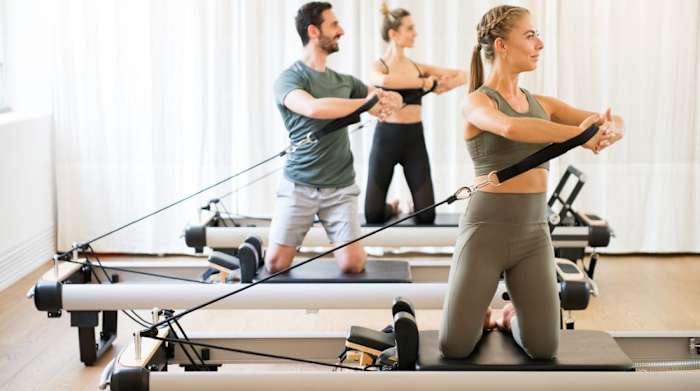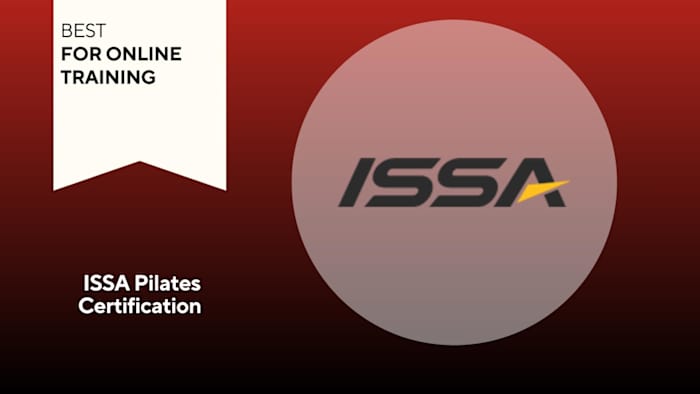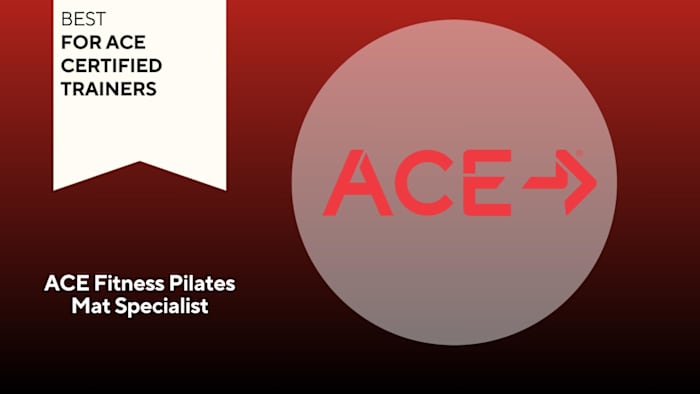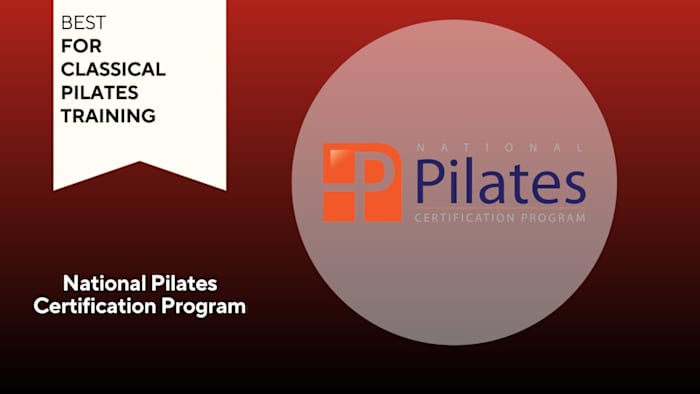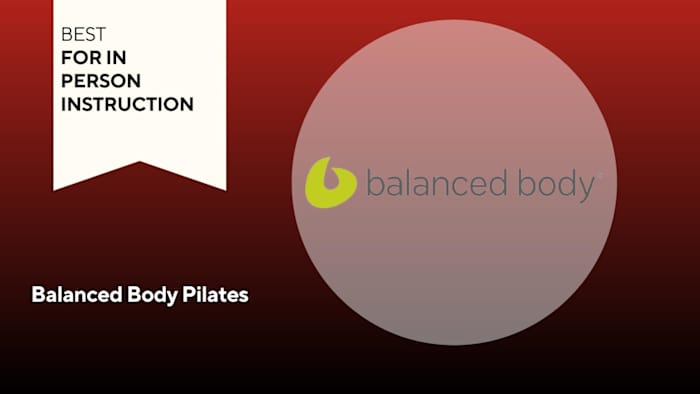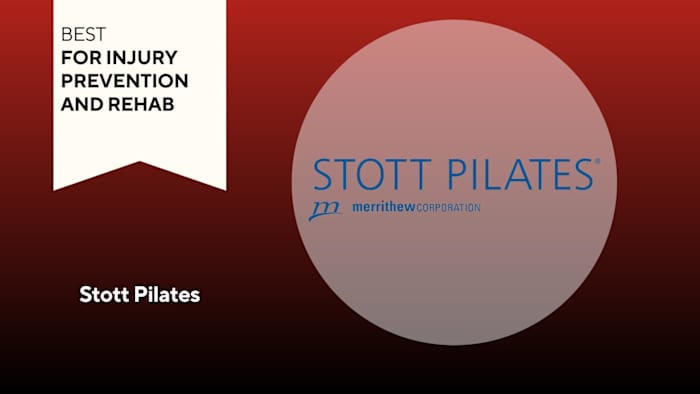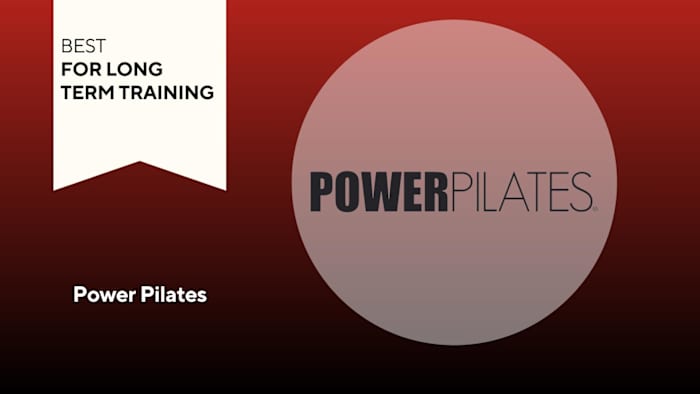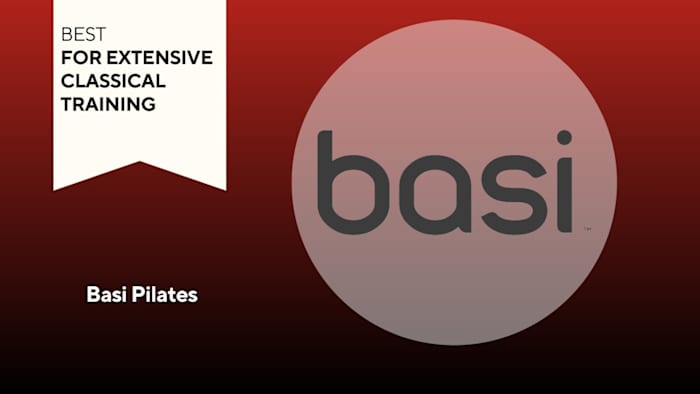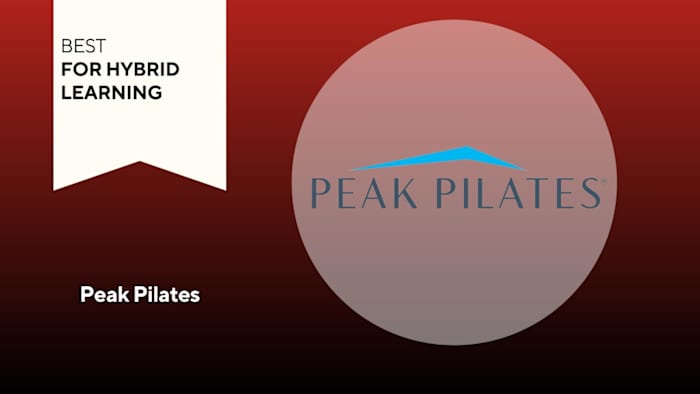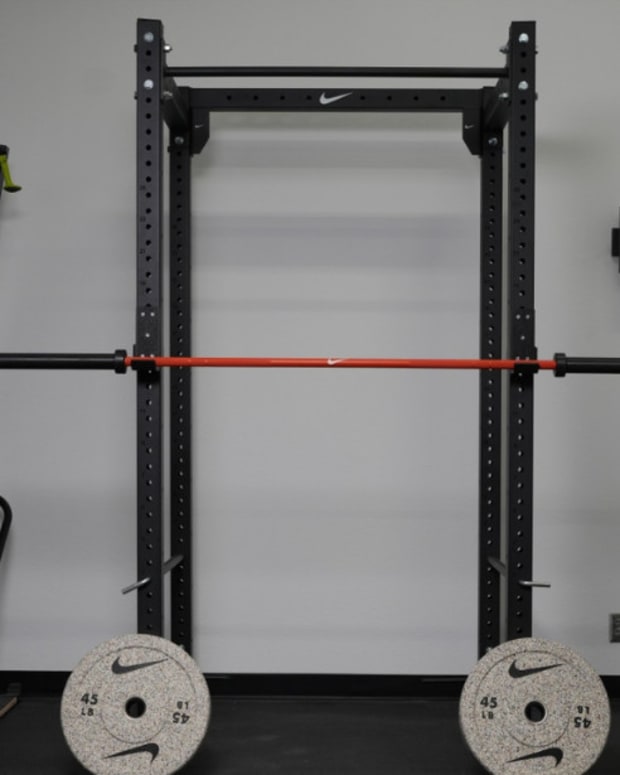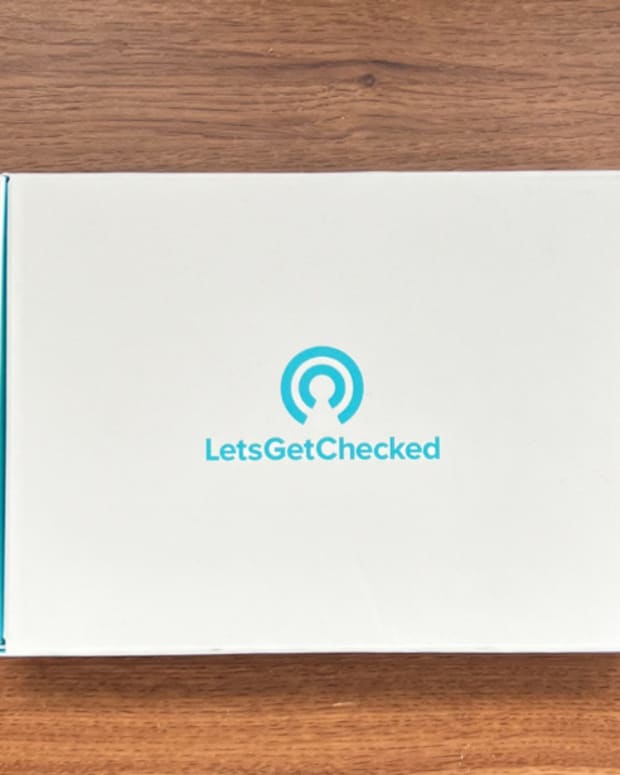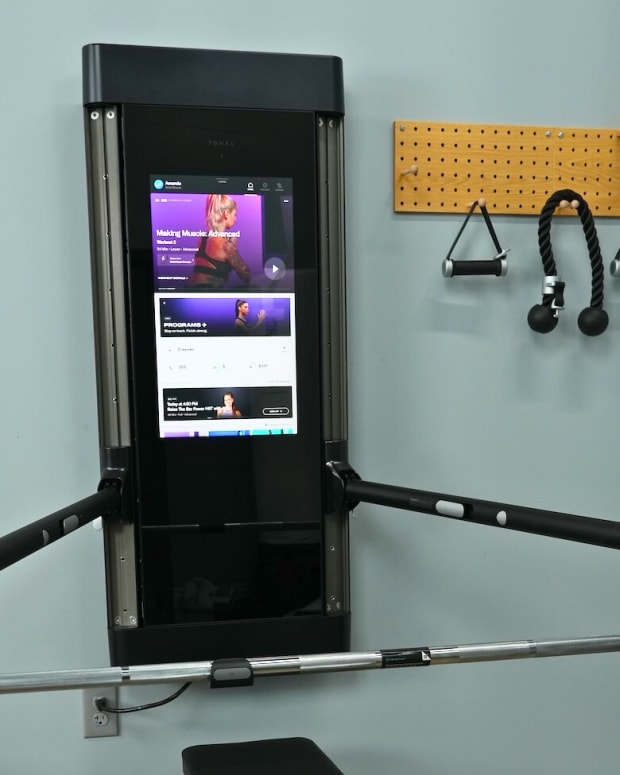The products featured in this article have been independently reviewed. When you buy something through the retail links on this page, we may earn commission at no cost to you, the reader. Sports Illustrated editorial staff are not involved in the creation of this content. Learn more here.
Though Pilates has recently skyrocketed in popularity due to celebrities touting it as their go-to workout, the exercise has actually been around since the 1920s. Developed by Joseph Pilates as a way to rehabilitate injured dancers, the moves are excellent at toning muscle and improving posture, core and back strength.
Pilates studios seem to be popping up left and right, and demand is on the rise—just check out your favorite fitness app or offerings on the personal training apps you use for home workouts, and you’re sure to find Pilates workouts. As you might’ve guessed, this means the demand for Pilates instructors is high. Whether you are a Pilates enthusiast, a retired dancer looking for a new career in movement or a certified personal trainer looking for specialized knowledge, earning a Pilates certification might appeal to you.
There are quite a few Pilates certifications out there, so we gathered details about eight we think are worth considering. Each program varies in curriculum, time commitment and cost, so you will have options no matter what type of education you are looking for. To see if a Pilates certification is right for you, read our reviews on our top picks.
Think you want a more general fitness education? Check out our reviews on the ISSA Personal Training Certification and the NASM Personal Training Certification.
Our Picks for the Best Pilates Certification:
- Best for Online Training: ISSA Pilates Certification
- Best for ACE Certified Trainers: ACE Fitness Pilates Mat Specialist
- Best for Classical Pilates Training: National Pilates Certification Program
- Best for In-Person Instruction: Balanced Body Pilates
- Best for Injury Prevention and Rehab: Stott Pilates
- Best for Long-Term Training: Power Pilates
- Best for Extensive Classical Training: Basi Pilates
- Best for Hybrid Learning: Peak Pilates
Best for Online Training: ISSA Pilates Certification
Key features and specs:
- Price: $799 or $53.27 over 12 months of interest-free payments
- Requirements: Must have active CPR certification (can be purchased as an add-on for $49)
- Curriculum: Anatomy and physiology, basic principles for health and fitness, client support, core and advanced Pilates exercises, modifications based on client’s abilities
- Study materials: Online textbook, section quizzes, on-staff professors, student forum
- Length of course: Self-led, must complete within 8 months
- Test type: Online exam
The International Sports Sciences Association (ISSA) is one of the most popular and well-respected personal training certification programs available. ISSA is well known for thorough curriculums. The Pilates Instructor Course touches on everything you need to become a Pilates instructor, from an overall understanding of human anatomy and physiology, to a general overview of principles for fitness and health, to more niche information like beginner to advanced Pilates moves. Plus, you’ll learn how to work within the individual limitations of clients. This program also covers important safety information like how to prevent injuries, and how to create both safe and effective training sessions in both a group and individual setting.
The course is self-guided, which means you can complete it in your own time and there aren’t any specific times or dates you must make available. It is also completed online—exam included—which allows you to complete the course in the comfort of your home. To help prepare you for the exam, you will have access to an online textbook, quizzes on each section of information, and you will even be able to contact a staff of professors if you have questions during your process. When you are finished, you will still have access to the material and can access support as you begin your Pilates teaching career.
What we like:
- You get a personal coach
- Test is online
- Can be done in your own time
- Wide range of topics covered
What to consider:
- Must have CPR certificate, or must add on to program
- You’ll need to find a studio to do an apprenticeship in
Best for ACE Certified Trainers: ACE Fitness Pilates Mat Specialist
Key features and specs:
- Price: $799
- Requirements: This is a continuing education course, so you must already have an ACE-CPT certification
- Curriculum: Theory behind Pilates and understanding of musculoskeletal system, how to tech goal-driven pilates classes and modify for individual clients, how to conduct yourself professionally in a class setting, how to open or work in a Pilates studio
- Study materials: Videos and two manuals
- Length of course: Self-led
- Test type: Two online assessments, documentation of 100 hours of apprenticeship, two 30-minute videos of you teaching a class and performing exercises
If you are already an American Council on Exercise (ACE) certified personal trainer looking to get a Pilates certification, this is the best choice for you. This certification technically an add-on—one of ACE’s continuing education course offerings—so you need to already have an ACE certification. Because of this, ACE certified trainers will likely have an easier time with this course, as they will already have a good base knowledge of physiology and overall training practices.
This course goes in-depth on training clients, modifying exercises based on physical capabilities or injuries and gives sage advice on how to teach in a professional setting. You’ll also learn how to manage the business side of things, like how to work in an established Pilates studio or how to start your own.
Note: this certification does require more work than just studying for an exam to pass. Along with two online assessments, you will have to complete 100 apprentice hours including 40 hours of observation, 30 hours of practice exercise at home or in a studio and 30 hours of practice teaching at home or in a studio. You will also have to submit two 30-minute videos of you teaching a Pilates class for critique by the course creator.
What we like:
- Very in-depth education
- Great option for ACE-certified CPTs
- Active learning helps you get real world practice
- Great for those wanting to start their own studio
What to consider:
- Must be ACE certified
- More work than just an online exam
Best for Classical Pilates Training: National Pilates Certification Program
Key features and specs:
- Price: $295
- Requirements: Must be 18 years old
- Curriculum: History of Pilates, 34 established Pilates exercises, anatomy, Modifications, contraindications, progressions and cueing
- Study materials: Observation hours, practice teaching, self-practice hours
- Length of course: At least 100 hours
- Test type: 100 multiple-choice questions, taken online at a testing center
While many Pilates certifications come from programs centered around personal training, this one is rooted in the teachings of Joseph Pilates. It focuses on the 34 core Pilates mat exercises, as well as teaching the history of the workout. The course also delves into anatomy to help you get a better understanding of what is happening when you perform each move. This helps to inform you in your own practice and allows you to properly modify exercises for different clients. You’ll also learn progressions in order to build fluid and effective workouts.
To help you study for the exam, you will have both observation hours (watching an experienced teacher) and experience practice teaching under the guidance of a certified Pilates instructor. You will also be required to complete self-practice hours to ensure you have personal experience with the exercises. This ultimately culminates in at least 100 hours of live or live virtual curriculum hours.
The exam itself will be taken online at a certified testing center, and it consists of 100 multiple-choice questions. To study for the exam it is recommended you read Return to Life by Joseph Pilates as well as access the NPCP study guide included with the course.
What we like:
- Based in core Pilates principles
- Affordable
- Gives hands-on experience
- Respected certification
What to consider:
- Does not cover reformer work
Best for In-Person Instruction: Balanced Body Pilates
Key features and specs:
- Price: Price varies per certification and classes
- Requirements: Pilates experience, related work experience, anatomy class
- Curriculum: Movement principles, mat classes; some require reformer, chair, barrel and trap
- Study materials: Instructor training manual, web access to DVD content
- Length of course: 134–520 hours
- Test type: Practical and written exam (multiple-choice, fill in the blank and essays)
If you want options, the Balanced Body program could be the right certification for you. Unlike most programs, which have one set Pilates curriculum, this one offers four different certifications including mat instructor training, reformer instructor training, mat and reformer instructor training and comprehensive instructor training. Each of these certifications requires different courses—going from the least amount of required classes to the most—and you will have the ability to add on eligible classes if you wish to take some outside of your program.
This is one of the best options if you are looking to teach specifically in a studio setting. All certifications (except the mat certification) require an anatomy class, and a movement principles class. Depending on which certification you are interested in, you will have multiple mat classes and reformer classes. In the comprehensive certification you will also learn chair, barrel, trap, and apparatus one, two and three. Each class will also require practical hours that include personal sessions, observation and student teaching hours.
These classes are taken in-person, so they will require more of a time commitment and will not be as flexible as an at-home option. The classes are taught in studios around the U.S. and around the world. This also gives a much more hands-on approach to the certification, which is great if you are looking to be an instructor—particularly with more niche classes like reformer or apparatus.
What we like:
- Very hands-on
- Classes offered around the world
- Teaches mat, reformer, apparatus and more
- Fully prepares you to be an expert Pilates instructor
What to consider:
- Very expensive
- All classes are done in-person
Best for Injury Prevention and Rehab: Stott Pilates
Key features and specs:
- Price: Price varies per location
- Requirements: Some training in dance, fitness or movement, at least 30 hours participation in Pilates classes
- Curriculum: Effective use of equipment, program development, effective communication skills, modifications, 295 exercises
- Study materials: Videos, instruction manuals
- Length of course: 165 hours
- Test type: Written exam and practical exam
Stott Pilates is a mixture of classical teachings and modern physiotherapy, so it’s a great option for those who are looking for a more clinical approach or are looking to teach Pilates from a more injury-preventative angle. This certification can be taken both in-person and online, or a combination of both depending on the courses you are taking. The comprehensive program has two options—either mat and reformer, or Cadillac, chair and barrels. There is also a more succinct intensive course with options for mat, reformer, or chair and barrels which is conducted over the span of two weeks or three weekends, and is ideal for those already in the fitness industry.
These courses will cover all Stott Pilates principles and how to apply them to Pilates exercises, including modifications for increased or decreased difficulty, modifications for specific body types or postural issues, how to correct movement patterns and form, programming options, effective communication, verbal cues and performance enhancements for clients.
There is a written exam that must be completed at a testing center, and a practical exam lasting anywhere from 40–110 minutes, and consists of information gathering, postural analysis, Stott Pilates principles and a workout which is conducted in the remaining time.
What we like:
- In-person and online options
- Great for rehabilitation approach
- Multiple certification options
- Fast track option for fitness professionals
What to consider:
- Prices vary by location
- Exam process is extensive
Best for Long-Term Training: Power Pilates
Key features and specs:
- Price: $5,495 (for U.S. locations)
- Requirements: Attend a minimum of 25 apparatus sessions, Complete the Power Pilates Core Mat I & Core Mat II trainings, basic knowledge of anatomy
- Curriculum: Memorize Pilates moves, weekend intensives, weekly advanced mat class, apparatus sessions, practice teaching, observation
- Study materials: Return to Life Through Contrology and Your Health by Joseph Pilates, basics of anatomy workshop, online apprentice exam aids
- Length of course: 600 hours, 6–12 months
- Test type: In-person evaluations
Power Pilates offers a comprehensive program that can be completed as a whole, or broken down into apparatus I, II and III. This certification is based on the classical style of Pilates developed by Joseph Pilates in the ‘20s, and teaches both mat and apparatus exercises. While this course does require a knowledge of anatomy, it is less science-based and more movement-based than some of the other options.
There are some online study materials but most of these classes are taken in-person—though some have virtual options—and will require a weekly commitment along with four weekend intensives. The course will also require teaching practice which can be done with fellow apprentices, but can also be completed with family and friends, allowing you some flexibility.
We cannot deny this is a pricey option, and in addition to the overall cost, you will also have to purchase your weekly mat classes and apparatus sessions as they are not included (though they do come at a discounted price). Observations can be done in-studio or online, so you do have some leeway there as well. While this course will leave you very well-educated, it will also take some time—600 hours, or 6–12 months—though it's worthwhile if you are looking to pursue a full-time career as a Pilates instructor.
What we like:
- Very comprehensive
- Focuses on hands-on experience
- Online and in-person options
- Locations around the globe
What to consider:
- Very expensive
- Very time-consuming
Best for Extensive Classical Training: Basi Pilates
Key features and specs:
- Price: $5,250 (fundamental and graduate combined)
- Requirements: N/A
- Curriculum: 10 movement principles, anatomy, posture assessment, core strength, exercise adaptation, muscle balance and imbalance, lower limbs shoulders, program design principles, specific populations 1 and 2
- Study materials: Notes taken at modules
- Length of course: 1,000 hours
- Test type: Online exams, observation hours, self practice hours, student teaching hours, practical final exam, written in-person final exam
The Basi Pilates certification offers a comprehensive course broken up into two parts. This program is completed mostly in-person and covers everything from basic principles to advanced Pilates work. The program is centered mainly around the classical style of Pilates, and teaches mat, chair, reformer, Cadillac and ped-a-pull, which makes it one of the most comprehensive Pilates educations available.
The program also teaches students how to make adaptations based on the abilities of their clients, and how to build effective programs they will be able to both teach and demonstrate.
In order to pass the program and apply for the certificate, you must attend all 12 modules, pass all online exams, complete 100 observation hours, 200 self-practice hours and 200 student-teaching hours. You must also pass a final written exam that is taken at a testing center, and a practical exam that will assess your skills in real time. You will be required to submit a final term paper at the end of your course.
In addition to the course fee, you will also have to pay $250 for the practical exam and $150 for the mat exam and teaching evaluation—plus some studios may charge a fee for your observation hours.
What we like:
- Covers all types of classical Pilates movements
- Course is broken up into two sections
- Lots of hands on and observation experience
- Customers praised the comprehensive education
What to consider:
- Expensive up front, plus additional exam costs
- Very extensive final exam
Best for Hybrid Learning: Peak Pilates
Key features and specs:
- Price: $350–$700 per module
- Requirements: CPR certification, background in anatomy recommended, minimum 20 hours of Pilates participation
- Curriculum: Apparatus technique, teaching and technique, mat, reformer and Cadillac, chair and barrels training
- Study materials: Study guide, exercise video library, PPT’s, practice audio and video support
- Length of course: 500 hours
- Test type: Online assessments and logged hours
Unlike most comprehensive programs that may empty out your bank account, Peak offers a program in three digestible modules. The modules can be completed one at a time, and there is no time limit in between, so you can spread out the education and payments as you like. These classes are also often taught Friday through Sunday, so they are much more manageable for those working a weekly job.
After completing each module and passing the online assessments, you will be eligible to teach Pilates at that level which is great for those looking to start teaching right away. It also allows you to get some experience before diving into teaching at an advanced level.
This course is based in the classical style, but it teaches Pilates movements on apparatuses including mat, reformer, Cadillac, chair and barrels. In order to pass each module, you will also have to log a certain amount of experience hours—120 for module one, and 60 for two and three—but overall the exam process for this certification is much less demanding than some of its competitors. This program also offers both in-person and online learning opportunities, so you won’t have to commit to a ton of time outside of the house, but you can still get in-person experience when you would like.
What we like:
- In-person and online options
- Manageable exam
- Comprehensive education is more affordable when broken up
- Can teach after each module is completed
What to consider:
- Pretty expensive
- Will still require some in-person classes
What is Pilates?
Pilates is a form of exercise developed by Joseph Pilates that was originally intended to help dancers recover from injury. Since then, it has become a popular low-impact activity is beloved for its high efficacy, and toning and strengthening results.
Since it was first developed, new variations of Pilates have popped up, including use of light weights and reformers, and even classes that incorporate physiotherapy movements. But no matter what form you may be doing, the exercise stays true to its core as both a mental and physical full-body workout.
Pilates is very focused on concentration of movement to specific muscle groups—namely the lower back and abdomen—flowing movements and controlled breathing. It is particularly great at improving strength, stability and endurance, and for many, greatly improves functional fitness. Since it was designed for dancers, it isn’t aimed at building big muscles, but rather strengthening and toning. Since it helps improve strength overall, it can also help to prevent future injuries.
Types of Pilates
- Classical Pilates: This is the original form of Pilates developed in the 1920s by Joseph Pilates himself. It usually combines both mat and apparatus exercises, and is focused on full body strength and movement with special concentration on the core. It is also a mind and body exercise that is led by the principles of centering, concentration, control, precision, breath and flow.
- Mat Pilates: One of the most popular forms of Pilates, this is often taught in classes and group settings. It requires little to no equipment and is suited to people of all ages and fitness levels. It is very low impact, and is the ideal method of self practice as you need only a mat and the optional foam roller, resistance bands and small balls.
- Contemporary Pilates (aka Stott Pilates): This form of Pilates is a mix of the classical style developed by Joseph Pilates and more modem moves that derive from modern physiology and physical therapy. It is aimed at helping develop optimal strength, flexibility, endurance and posture, without building bulk or stressing joints. This method also uses a neutral spine that embraces the natural curvature of the back unlike the classical method which favors a flat back.
- Reformer Pilates: This form of Pilates is done on a machine called a reformer which provides resistance through springs and pulley systems. This is often used in clinical settings for rehab and physical therapy, and is an excellent way to work on technique and heal/prevent injuries.
Benefits of Pilates
One of the biggest benefits of Pilates is the aesthetic aspect. Many find the exercises produce a lean and toned look in a healthy way. There are also physical benefits that come along with incorporating exercises into your routine.
Since Pilates is so focused on core and back strength, it can play a huge part in improving posture, and relieving lower back pain by strengthening and balancing out some of your most used muscles. And since everything is attached to your core, keeping it strong and sturdy can also help to alleviate pain in other parts of your body like the hips, knees, shoulders and more.
Pilates also improves flexibility. Many of the exercises include stretches that will help to increase mobility and help prevent muscles from tensing up and causing pain. Along with improved flexibility, balance and coordination were also incredibly important for dancers, and therefore are a staple of the Pilates practice. Increased stability and balance also stems mostly from core strength, but Pilates also includes many exercises that improve proprioception and help to decrease fall risks.
And not only can Pilates benefit you physically, but it can also help to improve your mental health. Breath control is a core part of any Pilates practice, and meditative and intentional breathing has been shown to help reduce depression and anxiety, according to a study published in Healthcare (Basel). Pilates also involves deep stretching and raising your heart rate, which can help boost both mental and physical health, according to Cleveland Clinic. Since this is a low-impact exercise, it is something that can be established as a daily practice.
How To Become a Pilates instructor
In order to become a Pilates instructor, the most important thing you should do is familiarize yourself with the practice of Pilates. This means taking classes and becoming well acquainted with the movements in your own body. Building Pilates practice into your daily life is imperative to being able to teach and encourage others to do the same. Also, having a personal practice routine allows you to better understand how recovery works, and how to help clients reach their fitness goals and potential safely.
Besides actively participating in Pilates yourself, you will likely need a certification to get hired; it will be particularly important if you are looking to open your own studio. There are a number of certifications you can choose from, ranging from fully online to all in-person classes at various locations. If you want the most comprehensive education—especially if you are newer to the practice of Pilates—you will probably want to opt for a certification with an element of in-person education. If you are already a certified CPT and/or you have a lot of previous experience practicing or teaching Pilates, you can probably get away with an online course as it is more for credibility than education.
Besides learning the basics of Pilates, how to teach different clients and how to run a successful business, a certification provides you with a level of credibility that gives employers and clients a level of trust in you and your abilities that can help to jumpstart your career as an instructor.
Once you are certified, you can go on to start your own studio (which is quite an undertaking) or, a more common route to start would be to work as an instructor in an established studio. This is a great place to start as it will help you build a client base and improve your skills as a Pilates teacher without the pressure of running your own business.
What do Pilates instructors do?
Pilates instructors teach classes either one-on-one or in group sessions. These classes can either be done on the mat (all floor exercises) or on a reformer; some classes will also be more adaptive, like seated chair Pilates.
Instructors will be able to lead a class through exercises to strengthen and improve fitness in a healthy way. They will be able to adjust exercises to the needs and abilities of each client, and provide adaptations based on their fitness levels. Instructors will also be able to correct form, and help clients improve their practice in a safe manner that will avoid possible injury.
Instructors also will usually plan workouts for classes of various types and levels as well as lead multiple throughout the day. This means you must have a good understanding of Pilates exercises and how to pair them as well as a solid fitness level to be able to perform and model exercises in each of your classes.
How to Choose the Best Pilates Certification for You
- Cost: No matter what you are purchasing, cost will always be a factor. These certifications have a pretty wide range of prices (from under $300 to multiple thousands). Depending on what you are looking for, there may be a couple options that fulfill your needs, so it’s best to look through all of them and compare prices to get the best bang for your buck.
- Course Requirements: This is one of the most important things to consider when looking for a certification program. Some courses are fully self-led, can be done in your own time, and even have exams that can be taken online. These are great if you are on a time crunch or have a full time job that you are working around. Some, however, will require teaching and observation hours, or class video submissions. These are usually the more comprehensive certifications, but they do take a great deal more work.
- Time Commitment: Time commitment varies from course to course, but some will take significantly more time than others. This can mean how much weekly work you have, how in depth the courses are, or whether you are required practical hours. If you do choose a course that is not self-led, you want to make sure you can commit to the time required so you do not end up overwhelming yourself and ultimately not finishing the program.
- In Person vs. Online: These certifications are done either fully online, fully in person, or a combination of the two. While neither is better than the other, there are some benefits to each. Online classes are easier to complete on your own time, are often faster, and can be more affordable. That said, it’s up to you to finish and pass the course on your own—though you usually will have access to online tutors. In person can be more expensive and more time consuming, but it’s great if you are more of a hands-on learner, and especially for those who are looking to teach, it can give you real world experience, and make you feel more prepared before venturing out on your own.
Our Methodology: How We Chose the Best Pilates Certification
To choose the best Pilates certifications on the market we gathered up eight of the most popular programs on the market. We chose certifications that were well-respected, but varied in price, curriculum, time commitment, exam type and more to give you a wide range to choose from.
These certification programs were highly rated by those that had taken them, and come from well accredited organizations that are accepted in the Pilates and fitness communities. Finally, we used our own personal training certification methodology—we evaluate experience and authority, accreditation, required material and technology, pass rate, value, continuing education, customer reviews, customer service and financing—to determine which Pilates certifications are the best.
Best Pilates Certification FAQs
How long does it take to qualify as a Pilates instructor?
Many certifications are self-led, but it can take anywhere from six months to two years to complete the work needed to gain a certification. To become a Pilates instructor, it is often required to log over 100 observation and teaching hours, so these rigorous certifications will take the most time.
Can you teach Pilates without a certification?
You certainly can teach, but having a certification will give you more credibility if you are starting your own business, and help you get hired if you are planning on teaching at an established studio.
Where do Pilates instructors work?
Pilates instructors can own their own studio, work for a Pilates studio, or teach classes at a gym.
What makes a good Pilates instructor?
A good Pilates instructor will have a great working knowledge of the activity and know how to teach a range of fitness levels, physical abilities, and ages in a safe and effective manner.
What is the average salary for a Pilates instructor?
Pilates instructors make a range of $54,000–$91,000 per year, according to Glassdoor.com.
Takeaway: Is a Pilates Certification Worth It?
If you are still questioning whether a Pilates certification is worth your time and money, the biggest question you should ask yourself is if you want to be a Pilates instructor. If the answer is yes, then investing in a certification is probably the way to go. The good news is a certification is a certification, so don’t feel like you need to opt for the most expensive and time-consuming option.
Ultimately, you want to choose the personal training certification that is most manageable for you, because it can be a great way to get your foot in the door for some on-the-job experience. And if you still aren’t sure if this is the right path for you—especially if you are newer to Pilates—we suggest getting more familiar with the practice. Take some classes, bring it into your daily practice at home—and if you decide Pilates is the right path for you, we have everything you need to know to choose the right program for you.
Prices are accurate and items in stock as of publish time.
